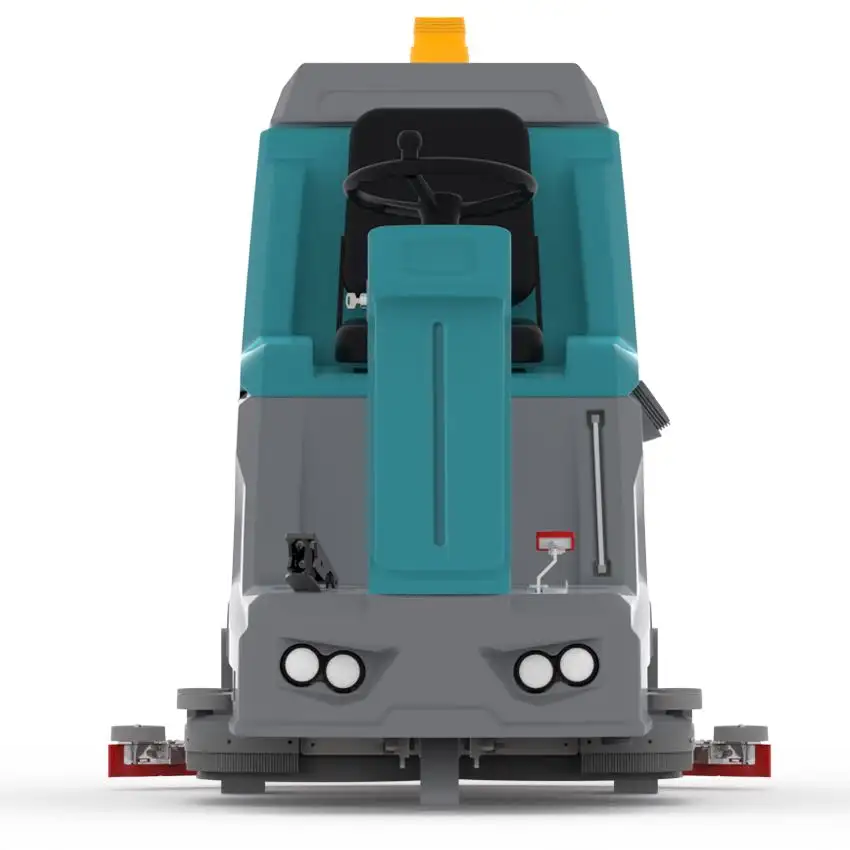The Evolution of Industrial Cleaning Equipment
From Brooms to Ride-On Sweepers: A Historical Shift
The journey from manual cleaning tools to mechanized solutions like ride-on sweepers marks a significant evolution in cleaning technology. Traditionally, methods like brooms and mops required substantial human effort and time, often resulting in inadequate cleaning of large areas. The introduction of powered cleaning equipment in the late 20th century spearheaded a new era in industrial cleaning. Major innovations, such as automated floor-sweepers and electric street sweepers, have transformed the industry. Data supports this transformation, showing a 50% reduction in cleaning time for large spaces by employing advanced cleaning equipment compared to manual methods. The shift to mechanization not only signifies technological progress but also highlights the industry's commitment to efficiency and effectiveness in maintenance practices.
How Floor Cleaning Machines Redefined Efficiency
Floor cleaning machines, especially ride-on sweepers, have transformed operational efficiency across various industries. These machines have improved efficiency by offering features like larger debris collection capacities and automated functionalities, which streamline cleaning processes. For instance, a study indicated that these advanced machines can increase productivity by as much as 30% compared to traditional methods like mops and brooms. Moreover, industry reports highlight the substantial gains in labor cost efficiency, as industrial cleaning equipment reduces the human resources required for extensive cleaning tasks. By minimizing dust and airborne particles, these machines ensure a safer and cleaner environment, thereby redefining what efficiency means in the field of industrial cleaning.
For those contemplating the adoption of floor cleaning technology, the transition to mechanized cleaning solutions offers both a reduction in time spent on cleaning and a promise of improved overall hygiene. As the industry continues to evolve, ride-on sweepers and their counterparts will likely remain at the forefront of this technological transformation, championing the cause of effective cleaning in large-scale settings.

Why Ride-On Sweepers Dominate Modern Cleaning
Enhanced Productivity in Large Spaces
Ride-on sweepers are known for significantly boosting productivity in large spaces, making them instrumental in modern cleaning solutions. These machines can efficiently clean expansive areas such as warehouses and parking lots, where manual cleaning methods would require excessive time and effort. For example, industries like manufacturing and logistics have seen remarkable improvements by adopting ride-on sweepers, which have led to faster cleaning turnaround times. Studies indicate that ride-on sweepers can clean up to 20,000 square feet in an hour, showcasing a substantial increase in productivity compared to traditional methods. This efficiency in cleaning vast spaces not only saves time but also reduces labor costs, further solidifying the dominance of ride-on sweepers in the cleaning industry.
Ergonomic Design and Operator Safety
The ergonomic design of ride-on sweepers ensures enhanced operator comfort and safety, key factors contributing to their widespread adoption. These machines are equipped with features that minimize operator fatigue, such as adjustable seating and user-friendly controls, allowing for extended use without discomfort. Safety is further accentuated by innovations like automatic braking systems and improved visibility features, which protect operators from accidents while enabling safer navigation around other machinery and pedestrians. Facilities utilizing ride-on sweepers have reported lower injury rates, underscoring their safer operational setup compared to manual cleaning methods. According to industry reports, these safety features have significantly reduced workplace incidents, making ride-on sweepers a preferred choice for maintaining clean and secure environments.
Key Advancements in Ride-On Sweeper Technology
Electric Street Sweepers: Eco-Friendly Power
Electric street sweepers have emerged as a leading eco-friendly solution in urban cleaning, providing a sustainable alternative to traditional fuel-powered machines. These sweepers significantly reduce both emissions and noise pollution, revolutionizing cleaning strategies in cities. According to environmental studies, electric sweepers can cut emissions by up to 90%, making them a crucial component in the shift toward greener urban environments. By reducing the carbon footprint and minimizing noise disturbances, electric street sweepers play a vital role in promoting healthier and more sustainable communities.
Smart Features in Tile Floor Cleaning Machines
Tile floor cleaning machines have seen remarkable advancements with the integration of smart technology, including sophisticated sensors and automated operations. These smart features enhance cleaning standards by enabling precise and efficient floor maintenance, leading to substantial operational efficiencies. Businesses adopting these machines report improved cleanliness metrics, as evidenced by numerous case studies. For instance, organizations have noted a significant improvement in floor hygiene and a reduction in cleaning time, highlighting the effectiveness of smart tile floor cleaning machines in elevating cleaning protocols across various industries.
Ride-On vs. Walk-Behind: A Comparative Analysis
Cost-Effectiveness and Labor Savings
The cost-effectiveness of ride-on sweepers compared to walk-behind models is a significant factor to consider. Ride-on sweepers offer substantial labor savings due to their ability to cover more ground faster and require fewer operators. Their design allows them to clean large areas efficiently, which translates to reduced labor costs. For instance, marketplace research indicates that employing ride-on sweepers can lead to a 35% reduction in operational costs. This savings is largely attributed to higher cleaning productivity and the ability to hire fewer operators, ultimately enhancing the profitability of a business.
Maneuverability in Complex Environments
Maneuverability is another critical consideration when choosing between ride-on and walk-behind sweepers. Ride-on sweepers offer advanced steering capabilities, making them ideal for navigating through tight spaces in complex environments. This ability is particularly valuable in settings like warehouses and retail spaces, where efficient navigation and cleaning are paramount. Conversely, walk-behind sweepers are better suited for smaller, more compact areas due to their size. User testimonials often highlight the ease of choosing the appropriate equipment based on the unique layout of their workspace. These insights can guide managers in selecting the right sweeper that meets their site's maneuverability needs optimally.
Environmental Impact of Modern Cleaning Solutions
Reducing Water and Chemical Waste
Modern cleaning technologies, such as ride-on sweepers, are revolutionizing the industry by significantly reducing water and chemical usage. These machines optimize the cleaning process, utilizing advanced methods to use fewer resources without compromising on effectiveness. By adopting these technologies, industries are embarking on initiatives that focus on sustainable cleaning practices. A notable outcome of this shift is a substantial reduction in resource utilization. According to environmental impact assessments, there's been up to a 70% reduction in water usage in industrial cleaning operations by implementing these advanced methods. This not only underscores the environmental benefits but also emphasizes the economic advantages of reduced resource consumption.
Low-Emission Designs for Sustainable Operations
Innovation in ride-on sweeper designs has paved the way for low-emission options, aiding in sustainable operations within industrial environments. These eco-friendly cleaners align with growing regulatory pressures aimed at minimizing emissions and promoting environmental stewardship. The market has seen a noticeable uptick in consumer demand for such sustainable products, prompting manufacturers to innovate. Examples of certified low-emission designs demonstrate this trend, showing significant market growth as reported by industry analyses. Such products not only adhere to strict regulations but also cater to a consumer base that increasingly prioritizes sustainability. This shift in production and consumer preference highlights a positive trajectory towards greener cleaning solutions.
The Economic Case for Ride-On Sweeper Adoption
Lower Total Cost of Ownership
Ride-on sweepers present a compelling case for a lower total cost of ownership (TCO) compared to other cleaning solutions, making them an economically intelligent investment. Several factors contribute to this cost advantage, including reduced maintenance expenses due to their durability and efficient design. For instance, many models incorporate robust components that withstand intense usage, reducing the frequency and cost of repairs. Financial breakdowns from companies like Tennant illustrate how investing in quality ride-on sweepers significantly lowers operational costs over time. According to industry reports, organizations that have switched to ride-on sweepers experience notable savings in labor costs. The machines' enhanced efficiency means fewer labor hours are required to maintain cleanliness, thus directly impacting the bottom line.
ROI Analysis for Industrial Facilities
Conducting a detailed ROI analysis shows that industrial facilities realize substantial benefits when adopting ride-on sweepers. The initial investment, though seemingly steep, is offset by recurring gains attributed to increased efficiency and reduced manual labor. Facilities such as large manufacturing plants have shared success stories where they've seen the ROI payback in a short time span, leading to well-informed purchasing decisions. Research further substantiates this by demonstrating enhancements in operational efficiency and customer satisfaction following implementation. For instance, facilities report improved cleanliness standards and better maintenance of expansive spaces with minimal physical effort, ensuring the upkeep of their infrastructure maintains high standards with less resource expenditure.
Future Trends in Ride-On Cleaning Equipment
AI-Driven Automation in Sweeping
The integration of AI technology into ride-on sweeper operations presents significant opportunities to enhance automation. AI-driven systems can optimize cleaning routes and schedules by learning from real-time data. This machine learning approach ensures that sweepers operate at peak efficiency, minimizing unnecessary repetitions and maximally covering targeted areas. Recent forecasts indicate a substantial rise in the adoption of AI-driven equipment, pointing to a future where intelligent ride-on sweepers will dominate commercial cleaning operations. As businesses seek to streamline maintenance processes further, the incorporation of AI promises to not only improve accuracy but also reduce operational costs significantly.
Battery Technology Advancements
The evolution of battery technology is crucial for enhancing the efficiency and reliability of electric ride-on sweepers. These advancements mean longer battery lives and faster charging times, which translate to smoother operational workflows with fewer interruptions. As batteries become more durable and robust, they can support extended cleaning sessions, ensuring that large facilities are maintained with minimal downtime. The market for battery-powered solutions is projected to grow substantially, driven by trends in renewable energy and an increased demand for sustainable cleaning practices. This shift supports enterprises in reducing their carbon footprint while maintaining high standards of cleanliness.
FAQ
What are the main benefits of ride-on sweepers over traditional cleaning methods?
Ride-on sweepers offer numerous benefits, including increased productivity, cost-effectiveness, enhanced operator safety, and environmental advantages. They cover large areas quickly, reducing labor and water usage substantially compared to manual methods.
How do electric street sweepers contribute to sustainability?
Electric street sweepers are eco-friendly as they significantly reduce emissions and noise pollution. By cutting emissions by up to 90%, they play a vital role in creating greener urban environments.
Why are ride-on sweepers considered cost-effective?
Ride-on sweepers lower the total cost of ownership due to their durability, reduced need for manual labor, and efficient large-area cleaning, which contributes to decreased operational expenses.
Table of Contents
- The Evolution of Industrial Cleaning Equipment
- Why Ride-On Sweepers Dominate Modern Cleaning
- Key Advancements in Ride-On Sweeper Technology
- Ride-On vs. Walk-Behind: A Comparative Analysis
- Environmental Impact of Modern Cleaning Solutions
- The Economic Case for Ride-On Sweeper Adoption
- Future Trends in Ride-On Cleaning Equipment
- FAQ
 EN
EN
 AR
AR
 FR
FR
 HI
HI
 JA
JA
 KO
KO
 PT
PT
 RU
RU
 ES
ES
 IW
IW
 VI
VI
 TH
TH
 MS
MS

